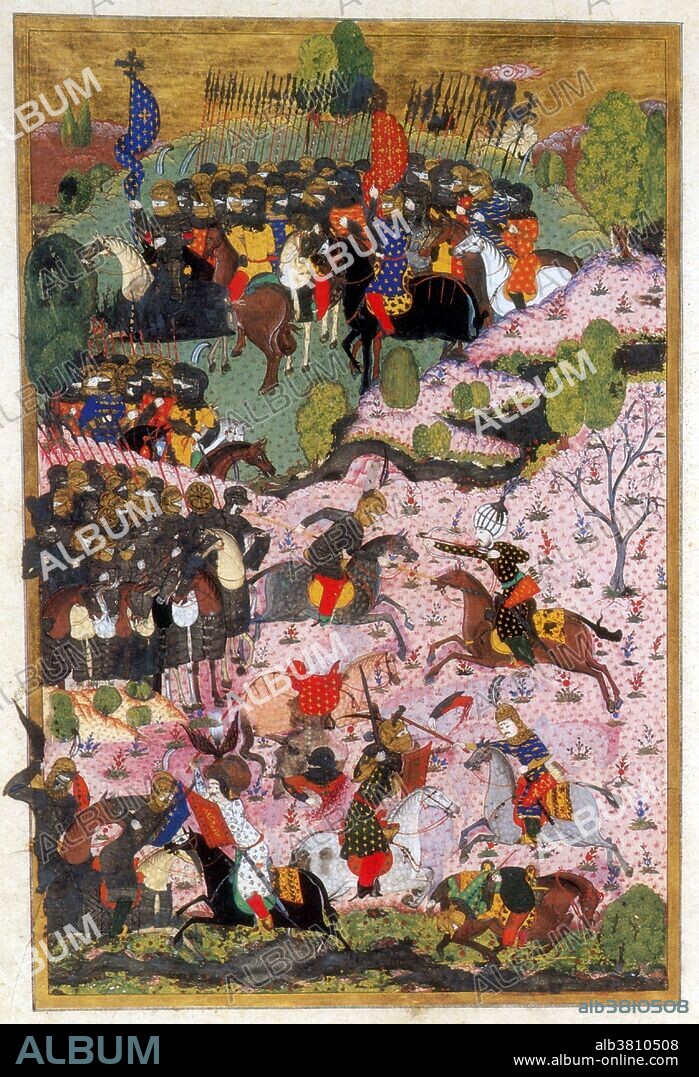alb3810508
Ottoman-Hungarian Wars, Battle of Mohà ¡cs, 1526

|
Add to another lightbox |
|
Add to another lightbox |



Buy this image.
Select the use:

Title:
Ottoman-Hungarian Wars, Battle of Mohà ¡cs, 1526
Caption:
The Battle of Mohács was one of the most consequential battles in Central European history. It was fought on August 29, 1526 near Mohács, Kingdom of Hungary, between the forces of the Kingdom of Hungary, led by Louis II, and those of the Ottoman Empire, led by Suleiman the Magnificent. Hungary had an expensive but obsolete army, reliant on heavily armored knights on armored horses. The Hungarian battlefront consisted of two lines, the first with a center of mercenary infantry and artillery and the majority of the cavalry on either flank. The second line was a mix of levy infantry and cavalry. The Ottoman army was a more modern force built around the elite, musket-armed Janissaries, and artillery. The Hungarians took serious casualties from the skillfully handled Turkish artillery and musket volleys. The Hungarians could not hold their positions, and those who did not flee were surrounded and killed or captured. The Ottoman victory led to the partition of Hungary for several centuries between the Ottoman Empire, the Habsburg Monarchy, and the Principality of Transylvania. Further, the death of Louis II as he fled the battle marked the end of the Jagiellon dynasty in Hungary and Bohemia, whose dynastic claims passed to the House of Habsburg.
Credit:
Album / NYPL/Science Source
Releases:
Model: No - Property: No
Rights questions?
Rights questions?
Image size:
3073 x 4500 px | 39.6 MB
Print size:
26.0 x 38.1 cm | 10.2 x 15.0 in (300 dpi)
Keywords:
1520S • 1526 • 16 16TH XVI XVITH SIXTEENTH CENTURY • 16 CENTURY • 16TH CENTURY • 16TH • ART • ARTILLERY • ARTWORK • BATTLE OF MOHACS • BATTLE OF MOHà ¡CS • BATTLE • BATTLEFIELD • BATTLING • BOOK OF SULEIMAN • CALIPH OF ISLAM • CAVALRY • CELEBRITIES • CELEBRITY • CHEVALIER • COMBAT • EUROPEA • EUROPEAN • EUROPEANS • EVENT • EVENTS • FAMOUS PEOPLE • FAMOUS • FIGHTING • FIRST STANDING ARMY • GENTLEMAN • GENTLEMEN • GUNPOWDER EMPIRE • HISTORIC • HISTORICAL • HISTORY • HORSEMAN • HUNDRED YEARS WAR • HUNGARIAN ARMY • HUNGARY • ILLUMINATED MANUSCRIPT • IMPORTANT • INFANTRY • INFANTRYMEN • ISLAM • ISLAMIC • JANISSARIES • KINGDOM OF HUNGARY • KNIGHT • KNIGHTS • MANUSCRIPT, ILLUMINATED • MILITARY • MINIATURE • MOSLEM • MUSKET-ARMED JANISSARIES • MUSLIM • NOTABLE • OTTOMAN ARMY • OTTOMAN EMPIRE • OTTOMAN TURKEY • OTTOMAN VICTORY • OTTOMAN • OTTOMAN-HUNGARIAN WARS • PAINTING • RIDER • SULEIMAN I • SULEIMAN THE MAGNIFICENT • SULEYMANNAME • SULTAN • SüLEYMANNâME • TURKISH EMPIRE • TURKISH • TURKS • WAR • WARFARE • WARS • WELL-KNOWN • XVI CENTURY
 Pinterest
Pinterest Twitter
Twitter Facebook
Facebook Copy link
Copy link Email
Email
